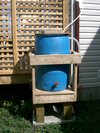- (https://b-ark.ca/ksKKwg)
I’m riding in the 2025 Enbridge Tour Alberta for Cancer, raising money for the Alberta Cancer Foundation, and have so far raised $2,744, exceeding my $2,500 goal and surpassing my 2024 effort!
Help me by donating here
And remember, by donating you earn a chance to win a pair of hand knitted socks!
Helloooooo Deck Railing!
Alright alright, I finally have pictures of the new railing up. Keep in mind, though, that there’s still work to be done. First, there’s a small rail that I need to install on the upper tier near the window well. Second, I need to install something in front of the window well on the lower tier (probably a railing, maybe a bench or something). Third, the stair to the ground still needs to be built. However, much of that will probably be put off for a week or two… I really need a break.
So, here we go:
As you can see, I’ve got the railing and the stair between the two levels completed. Looks pretty nice, if you ask me. ;)
Honeywell Wanted My Soul Today
So I just had the weirdest salesman/door-to-door guy bother me. This wasn’t the usual hard sell thing, as I first expected. Instead, what they wanted to do was place a sign on our property to advertise Honeywell (specifically, their home security products), and in exchange they would pay us. How could I possibly say no?? Well, you see, the problem is I’m already pissed enough at the sheer ubiquity of advertising, and the last thing I wanted was my house to turn into a glorified billboard. Not to mention the fact that I think home security systems are largely overrated (it’s not like it would take more than ten minutes to break one of our windows and steal a bunch of valuables) and are nothing more than a way for companies to cash in on fear.
So, unsurprisingly, I said “fuck that”… though in somewhat more polite language. But the best part was the guy’s reaction. “But… we’re gonna pay you.” he replied, as if the price of my soul, not to mention my values and dignity, were so easily purchased. He seemed genuinely puzzled, not to mention a little put off, that I didn’t want to become a Honeywell marketing tool.
Well, to Mr. Marketing guy and to Honeywell, I say it again: fuck that. I already have to constantly put up with advertisements. Everytime I browse the web, turn on the TV (after I’ve already paid for cable), or go to the theatre (with a ticket I already paid for), I’m bathed in advertisements and product spots. Why would I want to pollute my nice little neighbourhood with even more?
Just a Little Note
I’ve finally fleshed out the page on my Rainwater Collection System. You can see a photo of the final product below:
Photos on the complete deck railing will be forthcoming shortly… :)
Holy Crap Weeds Suck
Okay, so we were dumb. We decided to lay down our topsoil and then wait months and months before getting our final grade approval, after which we could look toward planting a lawn. Well, it turns out that the local flora absolutely love fresh black dirt, and the result was a veritable forest, nay, jungle of weeds.
The problem is, tomorrow we are supposed to have some inspector come to verify our final grade. And I can only assume that the poor sucker will want to, you know, be able to see the ground. So, I decided it was time to weed. Two and a half hours later, give or take, I was done, and the result was this:
Notice the barbecue, which I placed beside the pile for reference (note, the pile is more oblong than round, so you’re seeing the broadside in that photo).
The weeds were so bad that the process basically involved blindly grabbing and pulling at whatever I could find. Which is, coincidentally, very similar to one of the basic forms in my highly refined street fighting technique (the other being the Homer Simpson form… you know, crying like a little baby until your opponent turns away in disgust, at which point you kick some back!).





